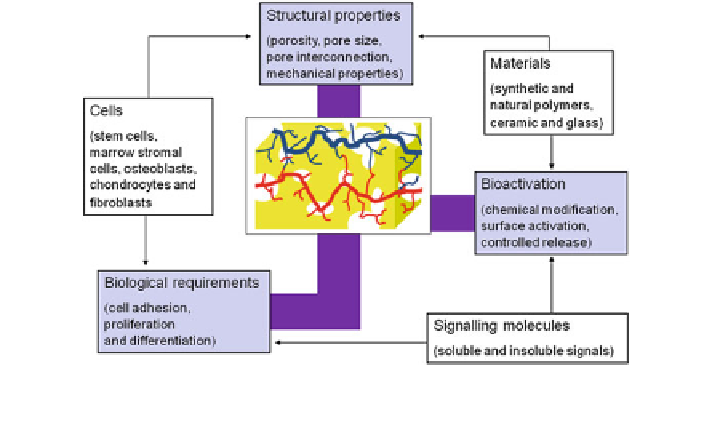Biomedical Engineering Reference
In-Depth Information
Fig. 3 Schematic diagram of key factors involved in the design of optimal scaffolds for bone
tissue engineering (modified from Ref. [
3
])
2 Scaffold Requirements
The success of a bone tissue scaffold is determined by its ability to stimulate and
aid in both the onset and completion of bone regeneration. Thus, the most
important function of a bone TE scaffold is its role as a template that allows cells
to attach, proliferate, differentiate and organize into normal, healthy bone as the
scaffold degrades. Figure
3
illustrates the most important factors involved in the
design of TE scaffolds and their interdependencies, according to Guarino et al. [
3
].
Depending on the final application, scaffold requirements include matching the
structural and mechanical properties with those of the recipient tissue and opti-
mization of the microenvironment to support cell integration, adhesion and
growth, issues that have become known as structural and surface compatibility of
biomaterials [
66
].
Considering the complexity of the TE task, scaffolds are subjected to many
interrelated biological and structural requirements which must be taken into
consideration when selecting a suitable biomaterial, fabrication procedure and
final scaffold structure and surface condition. Firstly, scaffolds need to promote
cell attachment, differentiation and proliferation, which are cell functions highly
dependent on substrate material properties. For bone engineering, scaffolds should
be osteoconductive, which is important not only to avoid the formation of
encapsulating tissue but also to induce a strong bond between the scaffold and host
bone [
3
,
4
,
34
]. The rate of biodegradation in vivo is another criterion for selection
of biomaterials for fabricating scaffolds. The scaffold degradation rate must be
tailored to match the rate of regeneration of new tissue. Further requirements are
related to the scaffold architecture. An ideal bone tissue scaffold should possess
interconnected porosity, i.e., it should be highly permeable with porosity and pore

Search WWH ::

Custom Search